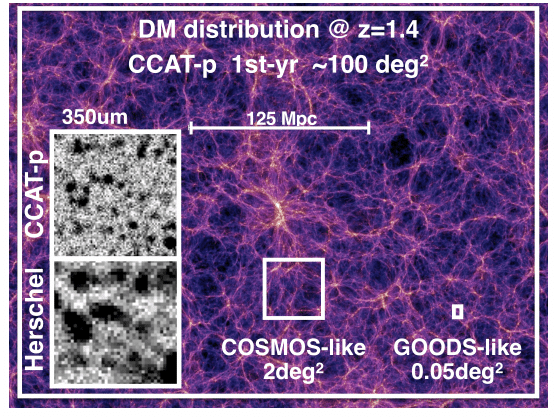Millimeter galaxy surveys

The CCAT-prime Galaxy Evolution Survey will be deeper and wider than any Herschel surveys, probing the full range of cosmic environments.
We lead and assist new millimeter wavelength blank field surveys to explore the formation history and properties of the highest redshift star-forming galaxies. Surveys at longer wavelength are known to find SMG at higher mean redshift than the shorter wavelength sub-mm surveys. We led an ambitious 2mm survey covering a significant fraction of the COSMOS field using GISMO at the IRAM-30m. We discovered 12 sources that suggest a 2 mm selection function with a median redshift of z ∼ 4 (Magnelli et al., in prep.), while prior SMG samples have median z ∼ 2.3. We discovered 12 sources that suggests a 2 mm selection function with a median redshift of z∼4, while prior SMG samples have median z ∼ 2.3.
We also led a 3 mm survey towards the entire GOODS-N field using 25 hours of MUSTANG-2 at the GBT, for which observations are completed and the data reduction is ongoing. We have also been involved in a deep 1.1 mm survey of the GOODS-S field using ALMA. This survey is the deepest over such large area made to date by ALMA. It contains massive galaxies (M∗ > 1011M⊙) with a median redshift of ∼2.9, yet their star formation rates are lower than those of classic SMGs, probing for the first time at mm wavelengths the bulk of the z ∼ 3 SFG population.
We have also been participating in large NOEMA and ALMA deep spectroscopic surveys lead by Fabian Walter and our former CRC student Manuel Aravena.
We plan to continue this efforts by “creating” surveys from the ALMA archive and preparing observations with CCAT-prime.